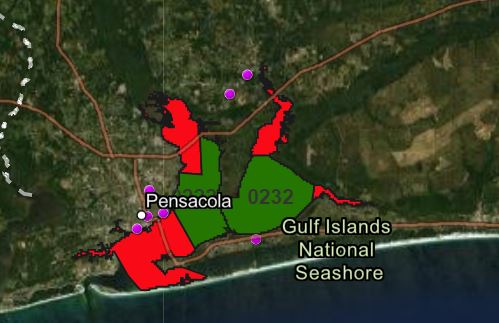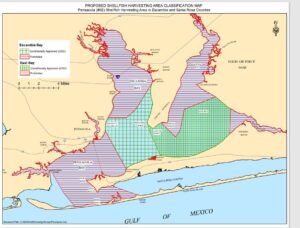
UPDATE: There is currently a temporary ban in place due to recent rainfall; however, sources say a separate, impending closure discussed below could possibly become permanent.
Portions of 0233 and 0232 will be closing soon. Graphic by the Florida Department of Agriculture and Consumer Services.
The State of Florida plans to close some local oyster and other shellfish harvesting areas, following high bacteria counts indicated per water sampling in East Bay and Escambia Bay.
The move concerns some local oystermen and stakeholders, including Captain Pasco Gibson of Bagdad, a lifelong fisherman who used to own and operate Nichols Seafood. “It will eliminate probably 70% of oyster beds in section 0232 (East Bay area),” he said, citing concerns that the prohibition could become permanent.
Christian Wagley, the Florida/Alabama Coastal Organizer for Healthy Gulf, said the closures are “triggering the relocation of an existing oyster farm in East Bay, significantly reducing the areas available for the harvest of oysters, and come as millions of dollars are being spent to restore oyster reefs and establish shellfish aquaculture in local bays.”
Wagley said stakeholders are calling on county and state leaders and local citizens to:
- fund and initiate additional research to pinpoint the specific sources of elevated bacteria levels in these areas;
- dedicate staff and other resources toward identifying the most cost-effective solutions for reducing bacteria levels. That could include the expansion of sewer service to low-lying and waterfront areas and better stormwater controls, among other solutions;
- have the state continue to monitor bacteria levels inside the new prohibited areas for future improvements in water quality that could allow these areas to reopen to shellfish harvest.
Gibson said continued monitoring is crucial to prevent a permanent closure. He also pointed a finger at what he suspects is to blame – septic tanks leaking into local bays and waterways.
“In my educated/experienced opinion this new closure is due to the increased population density along and near our miles of pristine coast with no infrastructure to support the growth (sewer systems). The mound system septic systems that have been used and are still being permitted today are only leaching sewage into our rivers and bays,” Gibson said.
Other stakeholders argue that in addition to the need for more sewer systems and septic-to-sewer conversions, stormwater runoff is also compounding the problem.
“If action to correct this problem is not taken immediately, we stand to lose a great ecological asset that this county has been blessed with,” said Gibson.
Toward that end, Pace Water System is currently looking to expand sewer service across Garcon Point. Additionally, Santa Rosa County is working with Triumph Gulf Coast on funding which could offset tap fees and other related costs. “It’s important for us to take the coastal septic sytems offline and put them on sewer,” said District 4 Commissioner Dave Piech, who is a member of the Pensacola & Perdido Bays Estuary Program. “I strongly support funding septic to sewer conversions, especially along our shorelines.”
For more information on local aquaculture visit: https://blogs.ifas.ufl.edu/escambiaco/2021/09/21/weekly-what-is-it-oyster-aquaculture/
































